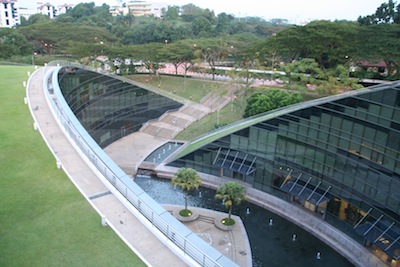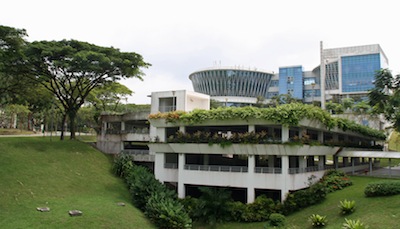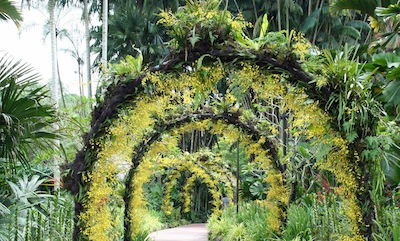By Judi Zienchuk
 As one of the four emerging Asian Tigers (along with Hong Kong, South Korea, and Taiwan), Singapore has developed quite a global reputation as a clean city full of great shopping. While the city does live up to its reputation, one thing that it does even better is promote green sustainability. Trees line highway medians throughout the city and the entire country is teeming with green roofs and gardens. The Arts, Design and Media building at Nanyang Technological University in particular is a salute to green architecture. It has been featured in several publications for its unique design of turf roofs that lower the building’s (and the surrounding area’s) temperature, decreasing air conditioning usage.
As one of the four emerging Asian Tigers (along with Hong Kong, South Korea, and Taiwan), Singapore has developed quite a global reputation as a clean city full of great shopping. While the city does live up to its reputation, one thing that it does even better is promote green sustainability. Trees line highway medians throughout the city and the entire country is teeming with green roofs and gardens. The Arts, Design and Media building at Nanyang Technological University in particular is a salute to green architecture. It has been featured in several publications for its unique design of turf roofs that lower the building’s (and the surrounding area’s) temperature, decreasing air conditioning usage.
Needless to say, this green innovation was not something that had been expected, coming into the third most densely populated country on Earth: Singapore hosted 7,792.57 people per square kilometer in 2012.
 All of this greenery is possible simply because the country understands that as a small island nation, it has a very limited amount of resources to work with. They have used this frame of mind to create an innovative sustainable development blueprint. This aims to improve energy efficiency by 35% by 2030, maintain a 70% recycling rate, and ensure 0.8 hectare of green space for every 1,000 people. This would total 4,146 hectares, or about 6% of the country’s landmass for a population of just over 5 million. In order to help utilize this space, many of the green areas around the city (such as the Chinese and Botanical Gardens) are open to visitors. This means that the city’s green space not only serves as a sustainable resource, but also educates tourists and Singaporeans alike on the importance of conservation.
All of this greenery is possible simply because the country understands that as a small island nation, it has a very limited amount of resources to work with. They have used this frame of mind to create an innovative sustainable development blueprint. This aims to improve energy efficiency by 35% by 2030, maintain a 70% recycling rate, and ensure 0.8 hectare of green space for every 1,000 people. This would total 4,146 hectares, or about 6% of the country’s landmass for a population of just over 5 million. In order to help utilize this space, many of the green areas around the city (such as the Chinese and Botanical Gardens) are open to visitors. This means that the city’s green space not only serves as a sustainable resource, but also educates tourists and Singaporeans alike on the importance of conservation.
 If you would like to purchase this article for your publication, please click here to contact the author directly.
If you would like to purchase this article for your publication, please click here to contact the author directly.
